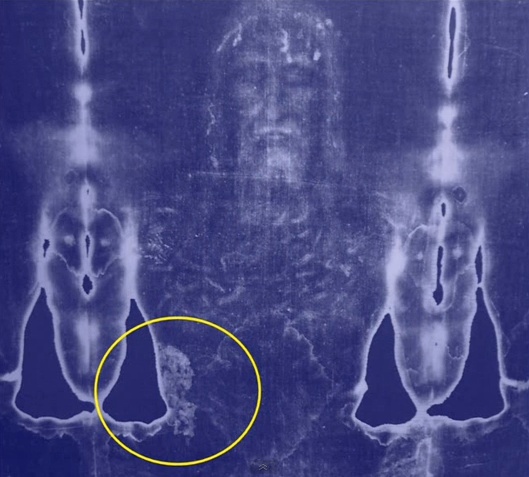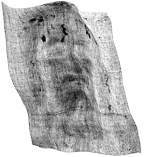Studio Sindone
The new website about the Shroud: a matter of reason, not of faith
A MESSAGE IN CODE FOR THE MAN OF THE 21st CENTURY?
by Antonio Bonelli
The conflict between faith and science, and between faith and reason,
is one of the most amazing swindle of human history.
Summary
- The "history" and its limits in the Shroud affair
- What's the response of "science"? - First Part
- What's the response of "science"? - Second Part
- How had that extraordinary image formed?
- The "affair" of the C14 dating
- Who is the man of the Shroud?
- Discussion
Who is the man of the Shroud?
The most obvious replay answer would be, we use the conditional for the time being, Jesus Christ. It is so because the evidence of Passion showing on the Shroud is totally consistent with the Calvary. It would in fact be nonsensical to state that the Shroud had wrapped not the body of Christ, but the one of unknown man, not only crucified with identical method, but also during the same historical period:
1) The fabric of the Shroud was fine, valuable and costly. In Israel only gentry and wealthy people could afford that kind of funeral wrap, so their fame would have certainly somehow reached us.
2) Before being crucified, the man of Shroud was methodically lashed on his whole body. The signs of the terrible Roman flagrum (flagellum taxillatum) do clear witness of that torture. Only in the Gospel we find the concordance of scourging and crucifixion represented together.
3) The head of the man of the Shroud was crowned, even more correctly, covered with a bush of thorns placed on head like an hood and crushed so that the thorns made score the meat and did bleed everywhere. Each thorn was like an electrical shock. The signs of wounds are clearly evident all around. It's a singularity likewise rather unique in history.
4) The chest of the man of Shroud was pierced through by a spear: the large stain of blood and serum on the right flank bears evidence of that wound, particular quite unusual on crucified men:

Fig. 9: the evidence of the flow of blood from chest,
the signs on the hair and on the rest of the body
5) The legs of the man of the Shroud was uninjured. In many cases the limbs were fractured to speed up the death, otherwise intervening many hours later for suffocation. The missing crurifragium(13) is quite atypical in the practice of Roman crucifixion.
6) The features of impression on the Shroud are consistent with Jewish-Palestinian burial's modalities of the first century. The body of the man of the Shroud was also quickly wrapped in the linen after the torment, otherwise the blood, which meantime it would be coagulated, could not impregnate the Shroud.
7) The Shroud shows no evidence of neither fluids nor gasses resulting from putrefaction. Such signs are generated by a decaying body about 40 hours past the decease. What we infer, from a medical point of view, is that the lying body was "separated" from the Linen just before such term, but anyway after the time necessary for the blood stains to be imprinted on it.
8) The body of the man of the Shroud was not removed by hand. In the case, the crusts of clotted blood had remained attached to the Linen in correspondence of wounds, but there are neither crusts on it, nor signs of dragging.
Now, although this is an incomplete list of coincidences, it cannot be reasonably excluded that one or maybe two of the aformentioned conditions could have been togheter also on other wretches gone through "the heart-rending wood". Never the less, is it really possible to deny in mathematic terms that the man of the Shroud is the Christ of the Gospel, when all the same conditions, all togheter are grouped on Him, as we read them in the texts of Gospel?
Since the Christoligical hypothesis cannot be positively "demonstrated", because the Scriptures don't hint at Jesus' identification marks, its reliability must be based on the infinitesimal unlikelihood of any alternative hypothesis. So, let's give the voice to numbers.
First to put the question in digits was the Frenchman Yves Delage (see Baima Bollone Sindone o no, Shroud or not), a sworn and well known agnostic professor of biology and comparative anatomy at Paris Sorbonne University. Taking into account the discordances between Christ's Passion as presented in the Gospel and in Pia's pictures on the Shroud's image, and that usually inflicted by the Romans, giving each of them a value of proof with an extra-large margin of error in minus, and multiplying each of them by all others as requires this kind of investigation, he came to the conclusion that ther's only one possibility in ten billions that the Turin image is not the one of the deposed Christ. By the way, when the gentleman presented his data to the French Academy of Sciences, the "Immortal" fellow-members with cocked hat felt outraged and refused to put his report in the proceedings. In 1972 another Frenchman, the engineer Paul de Gail (see Donavan) put that value at one in 225 billions. In 1978 the American Stevenson and Habermans of the STURP team came down to one in 83 millions. None of them, however, had taken into account the variables of the coin.
It was the above-mentioned Filas (cited by Stevenson and Habermas), who made a statistical study based upon the congruences of the several elements of the coin of the Shroud (namely size, outlines, design and angular perspectives) with the same ones of a wrong lituus. The outcome fixed in one in a not even pronounceable figure the likelihood that the found congruences were fortuituous...
For Donavan, the chance was one in 282 millions.
So, if only a single one chance in billions - but let's talk of "only" millions - is in favour of a given hypothesis, is it enough to invalidate it? Not at all!
Notes
(13) The rupture of the legs inflicted to persons dying on the cross, to prevent from somehow supporting themselves. By that means, their agony was shortened, and death came sooner for eshaustion and asphyxia. According to the evangelist John (19,31-33), only the two men condemned with Jesus suffered crurifragium, whilst Christ had it spared because foud already dead by the soldiers charged with the task.






